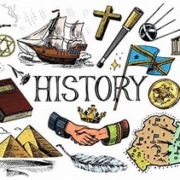The Urgency of History by Lois Bolin, Ph.D., Old Naples Historian
 New and Old are two opposing ideas that frequently embody transformation and custom. New embodies creativity, advancement, and contemporary life, whereas Old evokes the past, sentimentality, and cultural legacy. Each carries its distinct merits. New often introduces thrill and novelty, while Old delivers comfort and reliability. In the end, the dynamic between New and Old is vital for fostering a vibrant, harmonious community that honors both forward-thinking ideas and time-honored practices.
New and Old are two opposing ideas that frequently embody transformation and custom. New embodies creativity, advancement, and contemporary life, whereas Old evokes the past, sentimentality, and cultural legacy. Each carries its distinct merits. New often introduces thrill and novelty, while Old delivers comfort and reliability. In the end, the dynamic between New and Old is vital for fostering a vibrant, harmonious community that honors both forward-thinking ideas and time-honored practices.
Step Back in Time
Imagine a pristine, expansive white-sandy beach lined with slender pine trees along the water’s edge and prickly scrub palmettos farther inland. Directly aligned with a 600-foot T-shaped pier extending into the sea, on gently rising ground, stands a modest three-story building featuring a front porch and a cupola atop its roof. This scene captures Naples in 1890, with that building being the Naples Hotel.
Constructed in 1888 by the Naples Company using local pine, the 16-room hotel offered lodging and meals for $3 a day. Guests occupied the second-floor bedrooms, each measuring 16 square feet and furnished with a chamber pot, washstand, bureau, and small table. (The third floor housed the servants’ quarters.) The ground level included the office, where manager Mr. Brockman welcomed visitors, along with a spacious parlor, dining room, and card room.
The grand opening on January 22, 1889, drew 20 guests, including Rose Cleveland—sister of the president—who was the first to sign the register. This ledger not only tracked visitors but also noted daily temperatures, birthdays, and details of fish caught, including types and quantities. Dubbed “Haldeman’s Clubhouse,” the hotel served as a hub for socializing, as well as guided boating and hunting excursions.
The initial guests were mostly acquaintances of the Haldemans, who constructed their own residence close to the pier and hotel along wide paths scattered with shells. Today, Palm Cottage—Naples’ oldest surviving home, built in 1895 as a boarding house—operates as a museum open to the public.
All dining took place at the hotel. With no local markets and boat deliveries arriving only three times weekly, meals featured whatever guests could catch, hunt, or forage. This might include quail, deer, turkey, or turtle, alongside fish like snook, mullet, oysters, or clams. Vegetables and fruits were either cultivated or gathered wild, such as eggplants, cabbages, beans, potatoes, tomatoes, oranges, bananas, avocados, lemons, and coconuts. Chickens were kept on-site, and pineapple fields were common. Without refrigeration, everything was prepared fresh and eaten immediately, with no leftovers. Naples’ first organic hotel.
The relaxed evenings were filled with games, taffy pulls, bingo, and sing-alongs for the children. Adults enjoyed charades, card games, and piano-accompanied singing and dancing, enhanced no doubt by liquid spirits.
By 1890, the hotel hosted 50 to 60 guests per season and remained modest until 1915, when an expansion wing was added and more cottages emerged.
The New Olde Naples Hotel
Fast forward 120 years, and oh, how my imagination delights in seeing the name, “Olde Naples Hotel” and pondered if this is how pioneering guests felt about this site nestled on two sun-kissed acres at the crossroads of now Gordon Drive, Broad Avenue, and soon to be storied Third Street South.
Drawing its inspiration from the legendary Naples Hotel of 1889, this new resort pays homage to the district’s historic architecture while elevating it with vintage finishes that evoke an era of refined elegance, timeless charm and contemporary luxury. If my imagination comes to fruition, the Olde Naples Hotel will not be just a destination-it’s will be an artistic amalgamation of history, indulgence, and warmth.
History Matters
From The Urgency of Memory, NEH Chairman Bruce Cole stated, “…collective amnesia is dangerous. Citizens kept ignorant of their history are robbed of the riches of their heritage… If Americans cannot recall whom we fought, and whom we fought alongside, during World War II, it should not be assumed that they will long remember what happened here on September 11. And a nation that does not know why it exists, or what it stands for, cannot be expected to long endure.”
Yes, history matters – our town matters – and our place in this town matters. A city or county is not a community without an understanding of its past – its traditions, stories, and civic commemorations from community members who came before us. By continuing to share these stories and local traditions, we help strengthen our community connection and ensure that local history is not lost or worse, rewritten.
See Dr. Bolin on 239LIVE! Podcast Fridays at 8 a.m.




Leave a Reply
Want to join the discussion?Feel free to contribute!